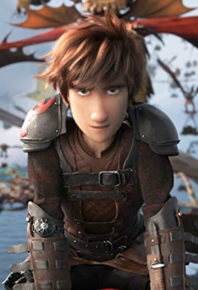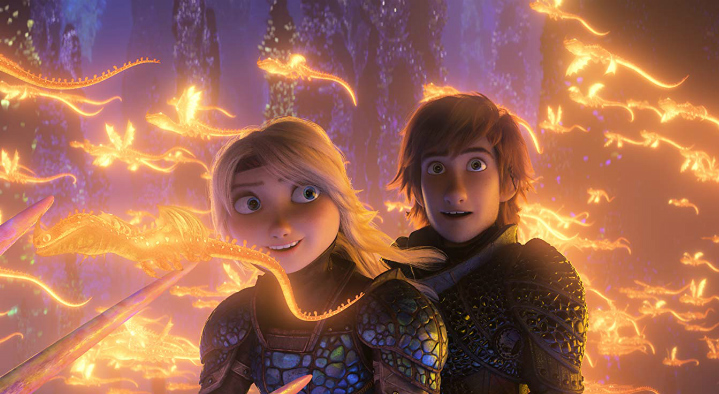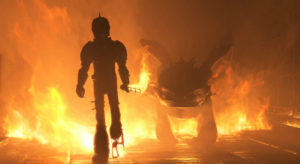
The How to Train Your Dragon films are the family movie equivalent of the recent Planet of the Apes trilogy. These series both skew a touch darker, and their themes are weightier than that of their popcorn flick ilk. Also in common: both franchises wrap up while they’re still on top. Director Dean DeBlois’ How to Train Your Dragon: The Hidden World closes out a trilogy that still has legs. If this is the How to Train series swan song, this thoughtful, touching, and enjoyable movie ends the series on a high note.
Now that Toothless has become the alpha, dragons and Vikings live together in bliss. Well, almost. Hiccup (Jay Baruchel), the island leader, transformed his society into a band of dragon hoarders. They take in dragons faster than they find places to put them. And despite Hiccup’s good intentions, his efforts at Viking/dragon utopia are unsustainable. Hiccup, along with Astrid (America Ferrera), Snotlout (Jonah Hill) and the rest of his crew are now a team of freedom fighters. They sneak onto dragon-trafficking ships under cover of night and pull off daring rescue missions.
With Hiccup and his friends hurting business, the dragon-traders turn to a ruthless hunter named Grimmel (F. Murray Abraham). Grimmel specializes in hunting Night Furies like Toothless, and he is shocked to learn that one still exists. The dragon-traders want Toothless and his alpha powers to take control of Hiccup’s dragon army, but Grimmel has ulterior motives. He only cares about the hunt. As Grimmel, the superior tactician closes in on Toothless, Hiccup decides there’s one thing left to do: run. And his best chance at hiding his fleet of dragons is discovering the location of the hidden world; a fabled land said to be the home of dragons.
How to Train Your Dragon: The Hidden World is packed with moments of jaw-dropping beauty. We’re only into February, but I’m calling it right now. The sequence where we first see the hidden world will stand as one of the most beautiful looking moments in cinema this year. I’ve seen every type of camera angle and tracking shot, and still, as the scene unfolded, I mouthed the word, “wow.”
The scene is an explosion of light and colour that looks like a combination of Coco’s neon-lit City of the Dead and those New York restaurants that string thousands of chilli-pepper lights from the ceiling. Moments as bold and imaginative as the hidden world reveal are the reason I don’t tire of going to the movies.
Even though the How to Train Your Dragon flicks use stylized character models, there are moments in this film so life-like that your brain forgets you’re watching animation. I found myself lost in the hypnotic beauty of how tall grass sways in the wind, sunlight breaks through the clouds, and the mist dances away from the edge of waterfalls. And the scrupulous attention to technical detail never to ceased amaze me; the peach fuzz on Hiccups cheeks, the texture of Toothless’ scales, and the wild strands of hair bristling out from Viking ladies’ braids.
I can’t stop singing the praises of this picture’s technical achievements. The action sequences are thrilling even though the action itself isn’t impressive (by action movie standards). What floored me was how the camera’s position felt grounded in the real world and always moved with a sense of purpose. And when the movement gets furious, the camera never loses you in the mayhem. This isn’t always the case in animated features. Here though, it’s exciting whenever the camera swings around to reveal a new perspective of the action.
Cinematographer Gil Zimmerman does a wonderful job conveying speed and motion, but the picture doesn’t neglect to slow down and capture tender moments. Every tilt and pan of the camera feels highly considered. This film features exceptional camera work, and I wasn’t shocked when I saw that capital “L” Legendary cinematographer Roger Deakins signed on as a visual consultant.
All the dynamic visuals wouldn’t pack as much punch if not for composer John Powell’s masterful score. Had I closed my eyes, I would have guessed I was listening to an epic Oscar-bate type of period piece. Not an animated movie about dragons. Powell’s work is essential to the film because dragons in this universe can’t speak. And DeBlois isn’t afraid to have us hang out with Toothless while the score does all the talking. Powell’s score sweet talks our hearts one moment and fills them with dread the next and sets the perfect tone for the film’s most powerful moments.
The How to Train Your Dragon trilogy speaks to me in a way that most other animated film series don’t. These movies don’t pull as many punches and yank at my heartstrings in ways that don’t feel cheap. Viewed as a whole, the trilogy feels cohesive, and Hiccups’ journey carries even more emotional weight. The three films explore identity, lineage, love, loss, parenthood, compassion, compromise, and most importantly, letting go. That these pictures do so with a cast of dragons that look like they’re pulled from a manga comic makes the message even more subversive.
Behind the Viking clans, warlords, tyrants, and fantastic beasts is a story grounded in genuine emotions. This series has always been about compassion, empathy, and understanding. It shows us how veering away from these principals leads to fear, hatred, and war. Only when we confront our fears do we get to the root of our anxieties, and agitations. This film implores us all to “train our dragons.” Especially when those dragons are scary notions such as loss and heartbreak. It tells us that heartbreak is inevitable, so don’t fear it — face it. Heartbreak is rooted in love. And with love comes the capacity to heal and love again. But only if we’re open to it.
- Release Date: 2/22/2019



